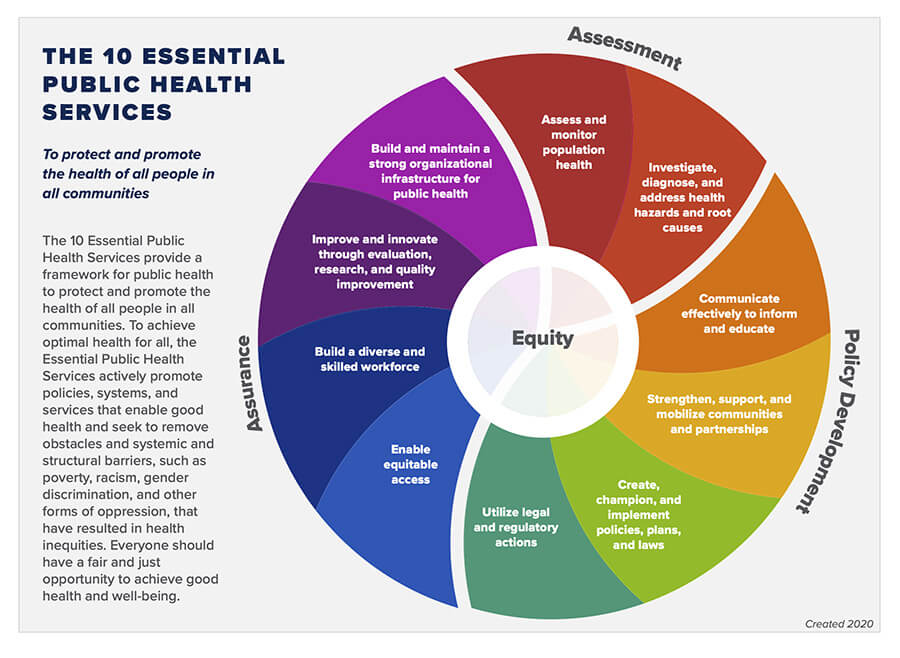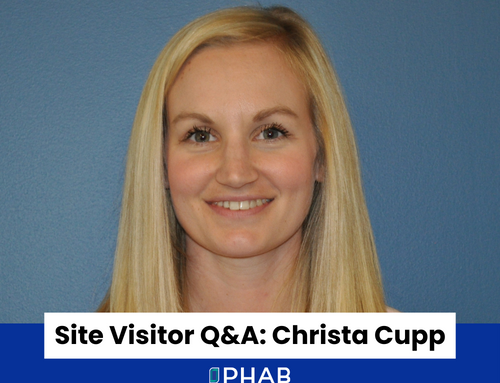On September 9, 2020 a revised version of the 10 Essential Public Health Services (10 EPHS) was unveiled during a virtual launch event. Developed with tremendous input from the field, the 10 EPHS are intended to reflect current and future public health practice. The 10 EPHS can also be used to spur innovation in your work, creating changes that better protect and promote the health of all people in all communities.
Public health innovation refers to the creation and implementation of a novel process, policy, product, program, or system leading to improvements that impact health and equity. Tenets of public health innovation include the following:
- It is an ongoing, systematic process that can generate incremental or radical change.
- It requires both collaboration with diverse team members and partners and co-production with people with lived experience who will be affected by the results of the innovation.
- It is an open process lending itself to adaptation or replication.

In many ways, the 10 EPHS can serve as a guidepost to spur innovation, supporting practitioners to implement the tenets of innovation within each service, across the services, in order to best protect the public’s health. Innovation is named throughout the services, and is specifically described as essential to public health work in Essential Public Health Service #9. Beyond that, the 10 EPHS have been, are being, and will be used as a blueprint to guide public health innovations. The following are five ways to use the revised 10 EPHS to promote and embed innovations in your work and examples of innovative initiatives that model each service:

- Equity – the Essential Public Health Services center equity in the framework and leave room for organizations to develop practices that meet the needs of all people in their community. As an increasing number of health departments, key stakeholders, and practitioners in the field declare racism a public health crisis, public health innovations will be essential to achieving health equity. The Cabarrus Health Alliance Connections Model of Care is one such example. Through this innovative program, comprehensive postpartum mental health care was provided to mothers experiencing peri-partum mood and anxiety disorder regardless of their country of origin or language spoken, socioeconomic status, or access to insurance. By providing support for mothers, the entire family benefits.
- Cross-sector Partnerships – Essential Public Health Service #4 emphasizes how important working across different sectors are to meeting the needs of communities. Cross-sector partnerships demonstrate a commitment to community, require trust and humility, and establish a space for collaboration. These partnerships can spur innovation as they require strategic engagement that touches on multiple social determinants of health that requires partners to come together and be creative in addressing issues collectively. In Ohio, Richland Public Health collaborated with the county’s library systems and the District 5 Area Agency on Aging on an innovative cross-sector partnership: Check Out a Book, Check Out a Blood Pressure Kit. Through this partnership, adults in the county could check out a kit for free and monitor their blood pressure more regularly from the comfort of their own home, increasing access to self-monitoring and identifying high blood pressure.
- Data Collection and Sharing – the Essential Public Health Services emphasize data throughout. With evolving technology and shifting trends, data collection is a crucial mechanism to describe what is happening in the field, connect with the community, and inform future work. Innovation in data collection, use, and sharing will support emergency response, cross-sector partnerships, and provide a better system for data analysis. The Chicago County of Public Health, with a limited number of sanitation inspectors, developed a way to systematically collect nearly 100,000 sanitation inspections and combine it with data collected by other city departments to forecast likely violations and inspect those locations first. Using data and analytics, inspectors were able to more efficiently do their job and keep patrons healthier.
- Workforce Development – Essential Public Health Service #8 focuses on the public health workforce. The EPHS are often used in staff training, but an innovative approach takes it further than knowledge to thoughtfully apply the framework to on-the-ground work and leadership development. This approach promotes innovative thinking to apply the goals of the EPHS to the evolving needs of the field. To advance health equity approaches, the Minnesota Department of Health (MDH) and MDH Center of Public Health Practice (CPHP) began offering a health equity learning community, which provided training and resources to local public health leaders upon request. Individual coaching was also provided to complement trainings to help local teams apply lessons to specific projects and be held accountable to taking action within their health departments. As part of the approach, CPHP encouraged local health departments to try new things and take risks, learn from their experiences implementing different activities, and not fear the potential for failure, all of which are key components to an innovation process and culture.
- Education –Continuous and culturally-appropriate education is an important part of the Essential Public Health Services, and is particularly relevant to EPHS #3. Effective communication, including platform, language, and trusted source, can help educate people about health and factors that influence it. In an innovative approach to education, Douglas County Health Department (DCHD) brought educational resources and free sexually transmitted disease testing to various community outreach locations, including concerts, haunted houses, community centers, libraries, and more to reach teens and young adults. Through this non-traditional STD testing and education model, DCHD was able to do something they never thought was possible.
To share how you have used or plan to use the 10 Essential Public Health Services in your innovation work, please email Naomi Rich, Program Specialist, at [email protected].





